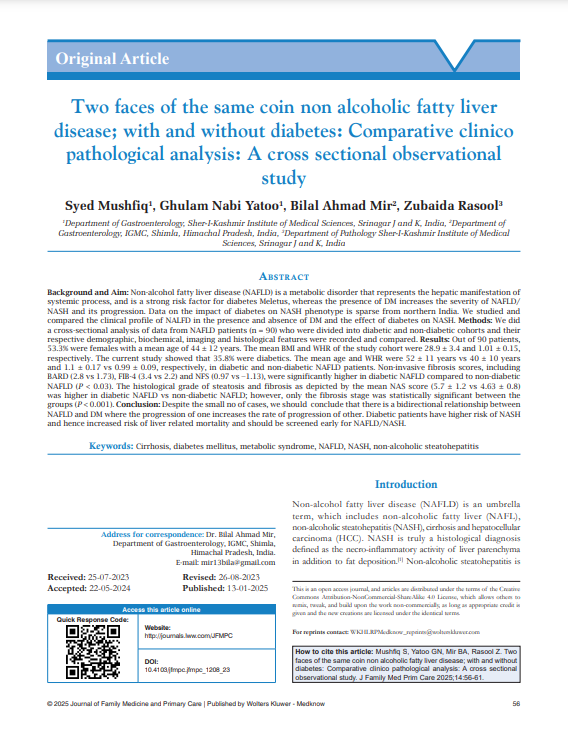Two faces of the same coin non alcoholic fatty liver disease; with and without diabetes: Comparative clinico pathological analysis: A cross sectional observational study
January 2025
Journal of Family Medicine and Primary Care
Abstract
Background and Aim:
Non-alcohol fatty liver disease (NAFLD) is a metabolic disorder that represents the hepatic manifestation of systemic process, and is a strong risk factor for diabetes Meletus, whereas the presence of DM increases the severity of NAFLD/NASH and its progression. Data on the impact of diabetes on NASH phenotype is sparse from northern India. We studied and compared the clinical profile of NALFD in the presence and absence of DM and the effect of diabetes on NASH.
Methods:
We did a cross-sectional analysis of data from NAFLD patients (n = 90) who were divided into diabetic and non-diabetic cohorts and their respective demographic, biochemical, imaging and histological features were recorded and compared.
Results:
Out of 90 patients, 53.3% were females with a mean age of 44 ± 12 years. The mean BMI and WHR of the study cohort were 28.9 ± 3.4 and 1.01 ± 0.15, respectively. The current study showed that 35.8% were diabetics. The mean age and WHR were 52 ± 11 years vs 40 ± 10 years and 1.1 ± 0.17 vs 0.99 ± 0.09, respectively, in diabetic and non-diabetic NAFLD patients. Non-invasive fibrosis scores, including BARD (2.8 vs 1.73), FIB-4 (3.4 vs 2.2) and NFS (0.97 vs −1.13), were significantly higher in diabetic NAFLD compared to non-diabetic NAFLD (P < 0.03). The histological grade of steatosis and fibrosis as depicted by the mean NAS score (5.7 ± 1.2 vs 4.63 ± 0.8) was higher in diabetic NAFLD vs non-diabetic NAFLD; however, only the fibrosis stage was statistically significant between the groups (P < 0.001).
Conclusion:
Despite the small no of cases, we should conclude that there is a bidirectional relationship between NAFLD and DM where the progression of one increases the rate of progression of other. Diabetic patients have higher risk of NASH and hence increased risk of liver related mortality and should be screened early for NAFLD/NASH.

